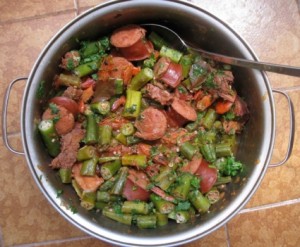
Photo © Michael Sommers.
The other night I gave a dinner party at my home in Salvador. I invited five close Bahian friends to whom I was “devendo” (owing) a home-cooked meal. In Bahia, unless you’re talking very upper crust, dinner parties are not very common. Instead, you get enormous mid-afternoon lunches that spill over with great ease into the evening hours. The number of guests is always in the double digits, icy beer and music are de rigueur, and the menu inevitably consists of a robust and highly flavorful main dish, cooked up in a gigantic cauldron, and garnished with fixings that usually include a simple salad, toasted manioc flour, and a hot pimenta “vinagrete”.Privately, I refer to these cauldron meals – which are always sufficient enough to feed a small army – as “adas” due to the suffixes involved. The most classic “ada”, of course, is Brazil’s national dish of feijoada; a velvety thick stew of beans (in Rio black beans are used, but in the Northeast the “mulato” variety is preferred) cooked with bacon, sausage, and various sundry parts of beef and pork (including cured pig ears, feet, and tails – which, true to my gringo upbringing, I subtly pick over). My friends are ranked according to their prowess at making feijoada (the talent for which is seemingly innate – either you’ve got it or you don’t), and those who are classified within the top tier enjoy a somewhat elevated status.
There is also rabada; an oxtail stew, often brightened up with green strands of watercress and vaca atolada, a robust stew of short ribs and manioc, especially popular in Minas Gerais, whose colorful name translates into “cow stuck in the mud.”
I’ve always been amazed by (and highly appreciative of) Brazilians’ knack for cooking up meals for 20 at the drop of a hat.Bahia has regional “adas” of its own such as quiabada (pictured above), a stew of diced green okra (quiabo), with chunks of beef, and seasoned with cilantro, cumin, and course, large leaf varity of mint known as hortelã grossa. A friend of ours who grew up in the parched Sertão interior is famed for his maxixada: whose main ingredient is a typical Sertanejo vegetable, the maxixe (which goes by the suggestive English name of burr gherkin). Jade-green maxixes, which are vaguely cucumber-like in taste, are the size of small potatoes and are covered in cactus-like prickles, which need to be scraped off before being added to chunks of salted beef and cooked until tender (the resulting dish is surprisingly light).
Anyway, I’ve always been amazed by (and highly appreciative of) Brazilians’ knack for cooking up meals for 20 at the drop of a hat. Culturally, such a feat is somewhat beyond me. I was raised in a household where preparing dinner for eight was A Big Deal and involved menu planning, individual servings, and multiple courses.
At any rate, for my dinner party the other night, I decided to do a variation of an “ada” by making, if not a cauldron, a sizable pot of boeuf bourgignon as a main course. (It’s sort of an unwritten rule amidst my social circle that I’m to steer clear of Brazilian dishes (leaving their preparation to my far more capable friends) and instead, to provide “exotic” gringo fare that my guests view with a mixture of delight (and perhaps occasional trepidation)).
The choice of a hearty French beef stew was perfect considering that, just that day, one of the first cold fronts of the autumn season had swept up from Argentina bringing winds, rains, and “cool” temperatures of 25-26 degrees Celsius. For this reason, I had also purchased a couple of nice bottles of Argentinian red. Some guests showed up with a bottle of red as well, but when I offered to serve them, I was met with funny stares. “It’s not cold yet,” said my friend Edivaldo, as he stashed the bottle in the freezer.
There are some cultural differences I’ll never get used to, and one of them is the frequent tendency in the hot Brazilian Northeast to serve red wine chilled (the exception being better restaurants). So while my friends, waiting for their bottle to freeze over, watched in mild disgust, I sipped my room temperature wine and pitied them their empty glasses.
Following the logic that Bahia is a hot place where liquids (even dry red wine) should be cool, you would have thought that my friends would have appreciated my opening course: a chilled, creamy vichysoise (with watercress substituting classic leeks). Not so. Although soups are very popular in these parts – there are actually “soparias” around town where people stop in after work for a bowl of hot nourishing soup and bread, which often substitutes dinner – cold soups are virtually unheard of and are viewed as a mystery (at best) and a travesty (at worst). Even though my most gastronomically adventurous friend, Edivaldo, defended the concept the others (he waxed enthusiastic about a chilled cucumber and yogurt soup I made years ago, but lost the crowd when he compared it to a “mousse”), I ended up having to heat the vichysoise (which was subsequently a great hit).
As for the main event, the boeuf bourgignon went down very well indeed – so well that plans were formulated to get me a cauldron so I could start selling the stuff, in true “ada” style, on a street corner, which in turn would lead to my becoming instantly famous throughout the city as well as rich as Croesus.
(Epilogue: Dessert – caramelized pineapple chunks, doused in cachaça, and topped with guava-cream sorvete – went without incident. As for the fact that I take my cafezinho without sugar, everybody is so accustomed to this oddity of mine that nobody batted an eyelid.)